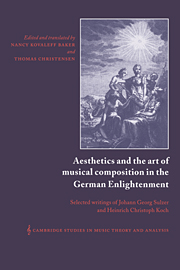 Aesthetics and the Art of Musical Composition in the German Enlightenment
Aesthetics and the Art of Musical Composition in the German Enlightenment Published online by Cambridge University Press: 30 September 2009
The very relationship between tones which makes it possible to join them harmonically also enables them to be connected melodically. A series of successive tones which share this relationship, that is, tones of an underlying key connected in a successive series, is called a melody.
A composition contains just as many different melodies as there are voices present. {4} Although (as we shall see) the main directions of these voices must arise in the soul of the creating composer together as one single picture to attain the proper aim of art, nevertheless these voices are not of one and the same nature, they do not have a common purpose. One of them contains, as it were, the sketch of the painting, the precise content of the ideal of the composer; this is called the principal part. Another serves him as the basis for the harmonic texture with which this picture is painted; this is called the bass voice. Others are present to contribute the drapery, the decoration, and finishing touches; these are called middle, filling, or subsidiary voices. The principal part of a composition is the one which, in the mechanical section of this treatise, I call the melody.
Remark
There are compositions, and even more single movements of them, in which {5} more than one voice has the character of principal part; in such pieces, the proper melodic content of the composer's idea may be realized only through the uniting of these voices.
To save this book to your Kindle, first ensure [email protected] is added to your Approved Personal Document E-mail List under your Personal Document Settings on the Manage Your Content and Devices page of your Amazon account. Then enter the ‘name’ part of your Kindle email address below. Find out more about saving to your Kindle.
Note you can select to save to either the @free.kindle.com or @kindle.com variations. ‘@free.kindle.com’ emails are free but can only be saved to your device when it is connected to wi-fi. ‘@kindle.com’ emails can be delivered even when you are not connected to wi-fi, but note that service fees apply.
Find out more about the Kindle Personal Document Service.
To save content items to your account, please confirm that you agree to abide by our usage policies. If this is the first time you use this feature, you will be asked to authorise Cambridge Core to connect with your account. Find out more about saving content to Dropbox.
To save content items to your account, please confirm that you agree to abide by our usage policies. If this is the first time you use this feature, you will be asked to authorise Cambridge Core to connect with your account. Find out more about saving content to Google Drive.